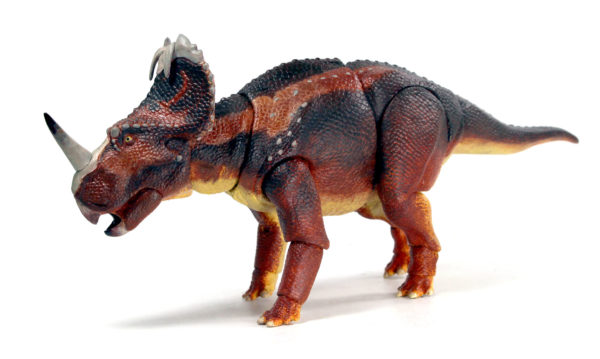What ever happened to Monoclonius?
In the offices at Everything Dinosaur, we have a large collection of prehistoric animal and dinosaur books, many of them quite rare and out of print. These have been collected over the years and in our quieter moments it is great to be able to thumb through them and look at the way our knowledge and the way in which dinosaurs are depicted has changed.
One of our favourites is “Dinosaurs and other Prehistoric Reptiles” written by Jane Werner Watson and featuring the wonderful illustrations of Rudolph Zallinger. Mr Zallinger was commissioned to produce a mural showing the evolution of dinosaurs by the Yale Peabody museum. His work went on display in 1947 and although our view of these animals has changed dramatically over the last 70 years; his artwork remains stunning. His highly detailed vistas of the Mesozoic landscape have inspired many to enter this field of science. They really are quite beautiful.
An Endearing Ceratopsian Image
One endearing image is a ceratopsian called Monoclonius (single horn). It is depicted in the (typical for the time), bent leg posture facing an approaching Gorgosaurus. However, scientists debate whether or not the name Monoclonius is valid, perhaps remains ascribed to Monoclonius should be re-classified to Centrosaurus.
A Juvenile Centrosaurus – Is the Monoclonius Genus Valid?

A replica of a juvenile Centrosaurus. The validity of the Monoclonius genus continues, the ontogeny of horned dinosaurs complicates the issue.
Complicated Taxonomic History
The taxonomic history of these two genera have been mingled together for nearly 100 years. In many situations, it is the lack of fossil evidence that cause problems for palaeontologists, however, with this particular group of Ceratopsidae the opposite is true. There is so much material to study that the case for acknowledging Monoclonius as a separate genus becomes blurred. Extensive Centrosaurinae bonebeds are known from the Dinosaur Park Formation (and other geological formations) of Alberta, Canada.
These sites have provided vast amounts of material, including complete specimens, as well as articulated remains and many skulls. Dodson provided the first review of the status of these two taxons in 1990 Dodson, P. “On the status of the ceratopsids Monoclonius and Centrosaurus”. He concluded that Centrosaurus and Monoclonius were sufficiently different from each other to be classified as separate genera. However, in 1997 Sampson and Tanke assisted by Michael Ryan reviewed this material, focusing their studies on the ontogenetic evidence from the Alberta bonebeds.
The bonebeds provide fossils of Centrosaurines of different ages, from young individuals to mature adults. This study built on the earlier work of Charles Sternberg and his report on the horned dinosaurs of Alberta that had been published in 1940. Sampson et al concluded that fossils that had previously been described as Monoclonius (M. crassus); showed evidence of belonging to immature individuals lacking adult characteristics. Based on this evidence the 1997 team declared Monoclonius a “nomen dubium”. Nomen dubium is a term used to describe an animal or plant whose validity is in doubt. Effectively, the fossils of Monoclonius were classified as belonging to young, sub-adult Centrosaurus.
Missing Monoclonius
The term Monoclonius continues to be used by dinosaur enthusiasts and some professional palaeontologists. The name was first used by Sir Edward Drinker Cope, the eminent American palaeontologist who named and described the first Monoclonius (M. crassus) in 1876. Thanks to the inclusion of the Monoclonius illustration by the likes of Rudolph Zallinger in many books, the name has seeped into popular culture and is perhaps better known than Centrosaurus.
The story of Monoclonius is far from over, a lot of indeterminate cceratopsian material from Canada and the USA is still referred to as belonging to Monoclonius. The largest skull of any centrosaurine yet found (CMN 8790), part of the Canadian Museum of Nature collection has been classified as Monoclonius lowei and as such might represent a valid specimen of Monoclonius.
As centrosaurines matured so their cranial ornamentation changed. Mature centrosaurs such as Centrosaurus apertus saw changes in the shape and size of their frill epoccipitals (the lumps and bumps of bone that were found on the edges of their neck frills). The first pair of epoccipitals became enlarged as the animal aged and formed hooks that curved over the opening in the skull (parietal fenestra). They resembled small bent horns, a feature picked up by Zallinger and included in his 1947 illustration of Monoclonius.
Beasts of the Mesozoic Models and Figures
The popular Beasts of the Mesozoic model series features several replicas of horned dinosaurs including centrosaurines. To view this range: Beasts of the Mesozoic Models and Figures.






Leave A Comment